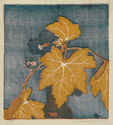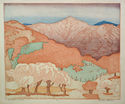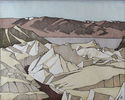
19th, 20th & 21st Century Fine Prints
707-546-7352 · fax 707-546-7924 · web: www.annexgalleries.com · email: artannex@aol.com
Anders Gustave Aldrin Biography
Anders Gustave Aldrin
American
1889–1970
Biography
Anders Gustaf Aldrin, painter, printmaker, and sculptor, was born in Värmland, Sweden on August 29, 1889. He immigrated to the United States in 1911, first moving to Chicago before settling in Minneapolis, Minnesota. Aldrin became a naturalized United States citizen on 23 August 1918 and the following month joined the US army. He was stationed in France and returned to the U.S. in June 1919. After the war, Aldrin became ill with tuberculosis and moved to Prescott, Arizona.
By 1920, Aldrin had relocated in Southern California and he studied at the Otis Art Institute, between 1923 and 1927, where he received the Huntington Assistance Award and a full scholarship to the Santa Barbara School of Art. While studying at the Santa Barbara School of Art (1927 to 1930), Aldrin learned the techniques of the Japanese color woodcut from Frank Morley Fletcher. In 1929, he studied for six months at the California School of Fine Arts in San Francisco before settling permanently in Los Angeles. That same year Aldrin made his first color woodcut and continued to experiment with the medium until 1937. Aldrin also studied at the Los Angeles Art Students League.
There has been confusion whether Anders Aldrin worked under the auspices of the WPA / California Federal Art Project as his family denies that he was part of the project and he is not included in the U.S. General Services Administration’s published book WPA Artwork in Non-Federal Repositories. However, anyone using this book for reference will discover numerous omissions in this record. In April 1970, Mildred Baker, Associate Director of the Newark Museum, wrote a letter to Robert Hunter, Assistant Curator, National Collection of Fine Arts, Smithsonian Institution, regarding the WPA allocation cards for prints which were distributed from the Washington office. Her letter states: “A card was made out for each print received in the Washington office from projects over the country. These prints were for allocation and for exhibition purposes. The three digit numerals under the titles indicated the exhibition in which the print was included.” She included copies of these cards and the one for Andrew G. Aldrin [sic] lists the titles of ten color woodcuts and one lithograph. There are exhibition numbers under four of the titles but it is not known what happened to these works. His work was included in the Eighth Annual Exhibition of American Block Prints, sponsored by the Butler Art Institute, in 1935 and Prints for the People. A National Exhibition, FAP/WPA, New York, January 1937.
Aldrin was a member of the California Art Club, the California Water Color Society, the California Society of Print Makers, and the Los Angeles Art Association. He exhibited both locally and nationally and solo exhibitions of his work were mounted at Scripps College, Los Angeles County Museum of Art, Pasadena Museum, and the Santa Barbara Museum. His work won several awards and is represented in the Boston Public Library, Massachusetts; the Zimmerli Art Museum, Rutgers University, New Brunswick, New Jersey; the Chaffey Community Museum of Art, Ontario, California; the Riverside Art Museum, California; the Fine Arts Museums of San Francisco, California; the Library of Congress, Washington, D.C.; the Wichita Art Museum, Kansas; and the Clark Museum, Williamstown, Massachusetts.
Anders Aldrin died at the V.A. hospital in Sylmar, California on February 24, 1970.









